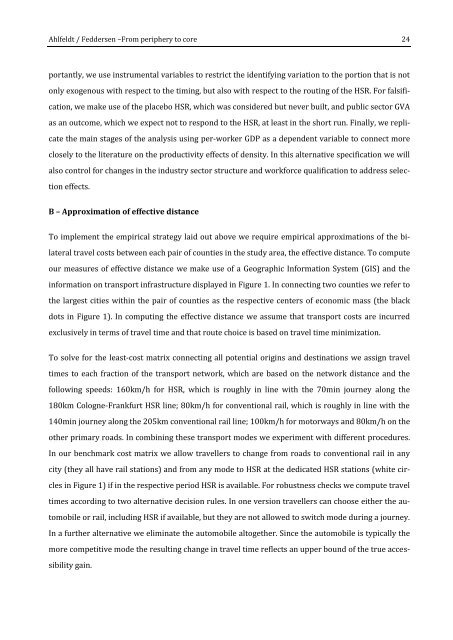sercdp0172
sercdp0172
sercdp0172
You also want an ePaper? Increase the reach of your titles
YUMPU automatically turns print PDFs into web optimized ePapers that Google loves.
Ahlfeldt / Feddersen –From periphery to core 24portantly, we use instrumental variables to restrict the identifying variation to the portion that is notonly exogenous with respect to the timing, but also with respect to the routing of the HSR. For falsification,we make use of the placebo HSR, which was considered but never built, and public sector GVAas an outcome, which we expect not to respond to the HSR, at least in the short run. Finally, we replicatethe main stages of the analysis using per-worker GDP as a dependent variable to connect moreclosely to the literature on the productivity effects of density. In this alternative specification we willalso control for changes in the industry sector structure and workforce qualification to address selectioneffects.B – Approximation of effective distanceTo implement the empirical strategy laid out above we require empirical approximations of the bilateraltravel costs between each pair of counties in the study area, the effective distance. To computeour measures of effective distance we make use of a Geographic Information System (GIS) and theinformation on transport infrastructure displayed in Figure 1. In connecting two counties we refer tothe largest cities within the pair of counties as the respective centers of economic mass (the blackdots in Figure 1). In computing the effective distance we assume that transport costs are incurredexclusively in terms of travel time and that route choice is based on travel time minimization.To solve for the least-cost matrix connecting all potential origins and destinations we assign traveltimes to each fraction of the transport network, which are based on the network distance and thefollowing speeds: 160km/h for HSR, which is roughly in line with the 70min journey along the180km Cologne-Frankfurt HSR line; 80km/h for conventional rail, which is roughly in line with the140min journey along the 205km conventional rail line; 100km/h for motorways and 80km/h on theother primary roads. In combining these transport modes we experiment with different procedures.In our benchmark cost matrix we allow travellers to change from roads to conventional rail in anycity (they all have rail stations) and from any mode to HSR at the dedicated HSR stations (white circlesin Figure 1) if in the respective period HSR is available. For robustness checks we compute traveltimes according to two alternative decision rules. In one version travellers can choose either the automobileor rail, including HSR if available, but they are not allowed to switch mode during a journey.In a further alternative we eliminate the automobile altogether. Since the automobile is typically themore competitive mode the resulting change in travel time reflects an upper bound of the true accessibilitygain.


